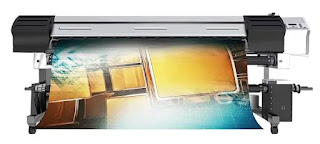The difference between wide format printers and plotters
Printing is essential to most business operations, with printing requirements varying by industry and business.
While many letter or legal-sized print jobs can be handled by standard office printers, those that require oversized stock — such as advertising posters, banners, architectural or engineering plan sets, and more — require a large format plotter or large format printer to meet size requirements.
However, the names are easily confused. A wide format printer and a wide format plotter have slightly different functions. Let's sort out the differences.
Wide Format Printers vs. Wide Format Plotters
While they can be an effective marketing tool, both wide format printers and plotters are expensive to own, so it's important to understand the differences and applications of both before investing in one for your company.
Wide Format plotter
Plotters are the original wide-format printing machines, dating back to 1959.
Wide format plotters are commonly used in the design, engineering, map-making, and construction industries to print vector-based line art on oversized plan sheets using permanent ink in drafting-style pens.
The way wide format plotters work has changed dramatically as a result of advances in technology. Instead of using pens, modern plotters can lay down ink using thermal, electrostatic, inkjet, or laser technologies.
A vinyl plotter, on the other hand, can use a blade rather than a pen to create simple but effective colored signs in vinyl and other fabrics.
Documents created by plotter printers can range in length from two to six feet, and the plotter generally lays down rather than sprays ink onto the page. These machines are more expensive than wide format printers, but they offer superior image quality for graphics with fine detail.
Plotters typically work with image files ending in.AI,.DWG, or.CDR that were created by programs such as AutoCAD, Flexi, and Adobe Illustrator, among others.
Wide format printer
A wide format printer, on the other hand, is typically an inkjet-based machine that can produce anything from a vehicle wrap to a magazine spread (though it can also use LED, copy press, thermal transfer, laser, and electrostatic technologies).
It can handle media up to two feet wide and two inches thick, such as paper, vinyl, glass, cloth, and wood.
Wide format printers produce printed images using raster (grid and pixel) images rather than vectors (lines), so changing the image scale when using a wide format printer can interfere with print quality.
These printers are intended to read images commonly produced by desktop software, such as.JPG,.BMP,.TIFF, and.PDF files.
Which Is Better, a Printer or a Plotter?
Because both wide-format plotters and printers can use a variety of printing technologies, from inkjet printing to thermal bonding and others, the main difference to consider is the type of files you most frequently work with.
When working with raster image files, a wide format printer is preferable, whereas vector files print more crisply on a wide format plotter.
However, some designers believe that a plotter, rather than a printer, is better suited for high-detail graphics due to image quality.


